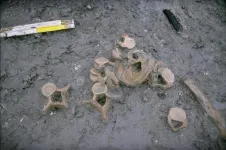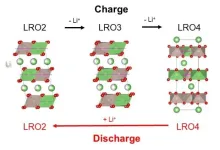(Press-News.org) Members of a hunter-gatherer group that lived in south-western Scandinavia during the Mesolithic era — approximately 10,000 years ago — may have been affected by tooth decay and gum disease, according to a study published in Scientific Reports.
Emrah Kırdök, Anders Götherström and colleagues sequenced the DNA found on three pieces of birch tar — a substance made from heated birch bark — that were excavated in the 1990s from Huseby Klev, Sweden and have been dated to between 9,890 and 9,540 years old. They created profiles of the microbial, plant, and animal species DNA found on each sample and compared these to those previously reported for modern human samples, ancient human dental plaque, and a 6,000 year old chewed birch tar sample
The authors found that the microbial profiles of the birch tar samples were most similar to microbes found in the modern human mouth, in ancient human dental plaque, and in a 6,000 year old chewed birch tar sample. This suggests that the samples from Huseby Klev were chewed by humans. They also found that they contained an increased abundance of several bacteria that are commonly associated with gum disease — such as Treponema denticola, Streptococcus anginosus, and Slackia exigua — and tooth decay — such as Streptococcus sobrinus and Parascardovia denticolens. Based on the relative abundance of microbial species in the birch tar samples and using machine learning models, the authors estimate that the probability that members of the hunter-gatherer group were affected by gum disease is between 70 and 80%. The authors suggest that the wider use of teeth to perform tasks involving gripping, cutting and tearing in ancient hunter-gatherer societies may have increased their risk of coming into contact with microbial species that cause gum disease.
In addition to microbial DNA, the authors identified DNA sequences consistent with those from a range of plant and animal species, including hazelnut, apple, mistletoe, red fox, grey wolf, mallard, limpet, and brown trout. These could reflect the materials that members of the hunter-gatherer group chewed prior to the birch tar samples. The authors speculate that these materials could have included food sources, furs, and bone tools.
The findings highlight the poor oral health of a group of Mesolithic Scandinavian hunter-gatherers and provide insight into their diet, material use, and local environment.
###
Article details
Metagenomic analysis of Mesolithic chewed pitch reveals poor oral health among stone age individuals
DOI: 10.1038/s41598-023-48762-6
Corresponding authors:
Emrah Kırdök
Mersin University, Department of Biotechnology, Faculty of Science, Mersin, Turkey
Email: emrahkirdok@gmail.com
Anders Götherström
Centre for Palaeogenetics, Stockholm, Sweden
Stockholm University, Stockholm, Sweden
Email: anders.gotherstrom@arklab.su.se
END
Genetics: Chewing over poor Mesolithic oral health
2024-01-18
ELSE PRESS RELEASES FROM THIS DATE:
Mega-analysis identifies gene variants associated with glaucoma in people of African ancestry
2024-01-18
PHILADELPHIA— A new analysis focusing specifically on people of African ancestry identified three gene variants that may be contributing to this population’s susceptibility to developing and being blinded by glaucoma. People of African ancestry are five times as likely as others to develop glaucoma and up to 15 times as likely to be blinded by the condition, but the vast majority of research has used data from people of European ancestry. Led by researchers at the Perelman School of Medicine at the University ...
Third major study finds evidence that daily multivitamin supplements improve memory and slow cognitive aging in older adults
2024-01-18
By 2060, according to the Alzheimer’s Association, nearly one in four Americans will be in an age bracket at elevated risk of cognitive decline and Alzheimer’s disease unless interventions can help preserve cognitive function before deficits begin. The COcoa Supplement and Multivitamin Outcomes Study (COSMOS) is a large-scale, nationwide, randomized trial rigorously testing cocoa extract and multivitamin supplements directed by researchers at Mass General Brigham. Two previously published studies of cognition in COSMOS suggested a positive effect for a daily multivitamin. ...
Nurse home visits have a lasting impact for disadvantaged mothers and daughters
2024-01-18
Nurse home visits to disadvantaged mothers can significantly reduce their rates of hypertension and their daughters’ likelihood of obesity, finds a new reanalysis of health data by a team led by a UCL researcher.
The study, published in the journal JAMA Network Open, reanalysed data taken as part of a Nurse-Family Partnership trial started more than 30 years ago – The Memphis New Mothers Study (1990-1994). The researchers found that prenatal and infancy nurse home visits decreased the likelihood of daughters being obese by 55% and being severely obese by 81% in adolescence. Similarly, mothers of girls showed a decrease ...
Cannabis and driving in older adults
2024-01-18
About The Study: The findings of this study that included 31 participants ages 65 to 79 suggest that older drivers, even if they regularly use cannabis, show evidence of impaired driving performance after smoking cannabis. Weaving was increased and speed was decreased at 30 minutes after smoking, which was not correlated with blood tetrahydrocannabinol (THC) concentrations; subjective experience and self-reports of impaired driving persisted for three hours.
Authors: Patricia Di Ciano, Ph.D., of the Centre for Addiction ...
Neurostimulation for advanced Parkinson disease and quality of life at 5 years
2024-01-18
About The Study: This nonrandomized controlled trial of 108 patients with advanced Parkinson disease found that at 5-year follow-up quality of life remained stable in the deep brain stimulation of the subthalamic nucleus (STN-DBS) group and worsened in the standard-of-care medication group, mainly driven by the favorable effect of STN-DBS on mobility. These findings may provide helpful information when counseling patients on the efficacy of STN-DBS for Parkinson disease and monitoring patients postoperatively in long-term follow-up.
Authors: Stefanie T. Jost, Ph.D., and Haidar S. Dafsari, M.D., of the University of Cologne, Germany, are the corresponding ...
Monell Center study: New gut-brain circuits found for sugar and fat cravings
2024-01-18
Philadelphia, PA (January 18, 2024) – Understanding why we overeat unhealthy foods has been a long-standing mystery. While we know food's strong power influences our choices, the precise circuitry in our brains behind this is unclear. The vagus nerve sends internal sensory information from the gut to the brain about the nutritional value of food. But, the molecular basis of the reward in the brain associated with what we eat has been incompletely understood.
Now, a new study published in Cell Metabolism by a team from the ...
Ancient chewing gum reveals stone age diet
2024-01-18
What did people eat on the west coast of Scandinavia 10 000 years ago? A new study of the DNA in a chewing gum shows that deer, trout and hazelnuts were on the diet. It also shows that one of the individuals had severe problems with her teeth.
Some 9 700 years ago, a group of people were camping on the west coast of Scandinavia, north of what is today Göteborg. They had been fishing, hunting and collecting resources for food. And some teenagers, both boys and girls, were chewing resin to produce glue, just after ...
Hidden cause of lithium-rich cathode materials’ low energy efficiency revealed
2024-01-18
1. A research team consisting of the National Institute for Materials Science (NIMS) and Softbank Corp. has found that voltage hysteresis in Li2RuO3—a high-energy-density rechargeable battery cathode material—is caused by differences in the intermediate crystalline phases formed during charge and discharge processes. Voltage hysteresis is a phenomenon detrimental to lithium (Li)-ion batteries in which discharge voltage becomes significantly lower than charge voltage. These results revealed a voltage-hysteresis-causing mechanism inconsistent with conventional theory.
2. ...
Next-generation batteries could go organic, cobalt-free for long-lasting power
2024-01-18
In the switch to “greener” energy sources, the demand for rechargeable lithium-ion batteries is surging. However, their cathodes typically contain cobalt — a metal whose extraction has high environmental and societal costs. Now, researchers in ACS Central Science report evaluating an earth-abundant, carbon-based cathode material that could replace cobalt and other scarce and toxic metals without sacrificing lithium-ion battery performance.
Today, lithium-ion batteries power everything from cell phones to laptops to electric vehicles. One of the limiting factors for realizing a global shift to energy produced by renewable sources — particularly for the transition ...
FAU Engineering receives $2.6 million NSF grant for CyberCorps student scholarship program
2024-01-18
The College of Engineering and Computer Science of Florida Atlantic University received a $2.6 million grant from the National Science Foundation (NSF) to establish a scholarship program in the burgeoning and critical field of cybersecurity. The NSF’s CyberCorps® Scholarship for Service program seeks to increase the number of qualified cybersecurity professionals working for federal, state, local, territorial and tribal governments.
The program is managed by the NSF in collaboration with the United States Office of Personnel Management and the U.S. Department of Homeland Security. FAU is one of only six universities ...



